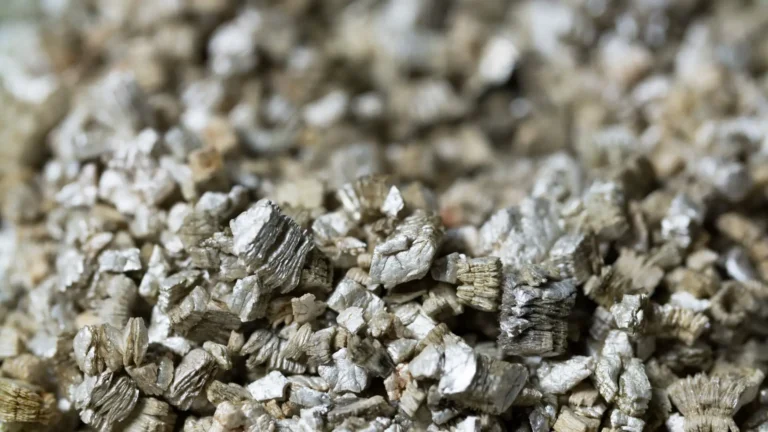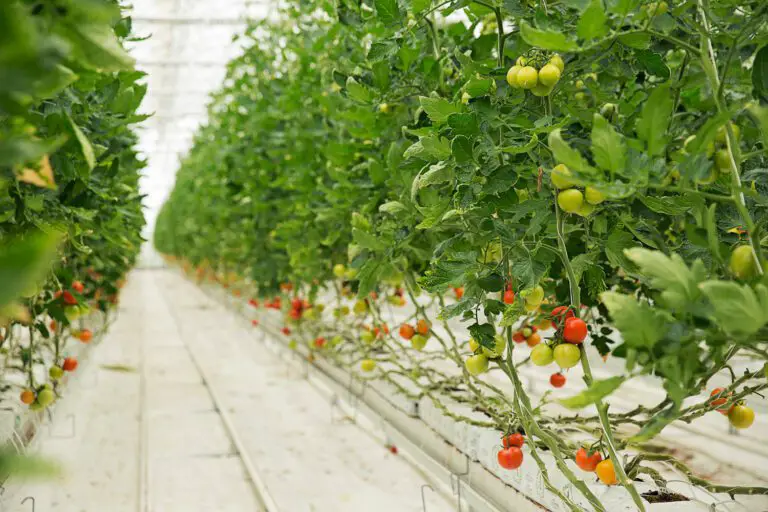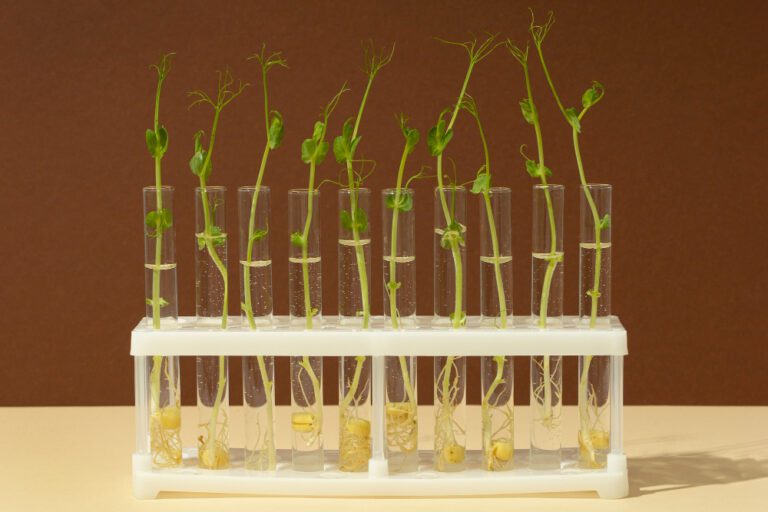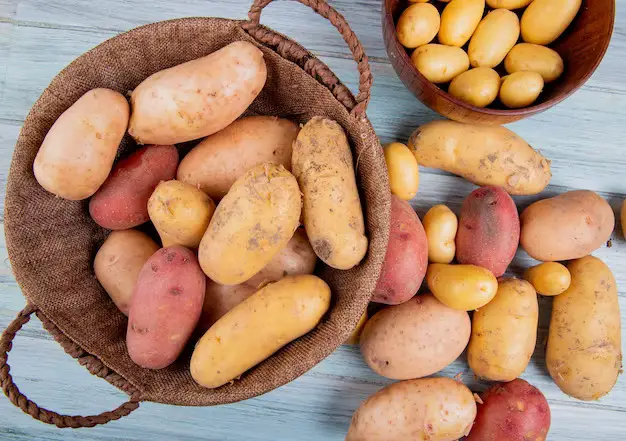Passive vs Active Hydroponic Systems: What’s the Best and Which 1 to Choose?
Table of Contents
What is Hydroponics?
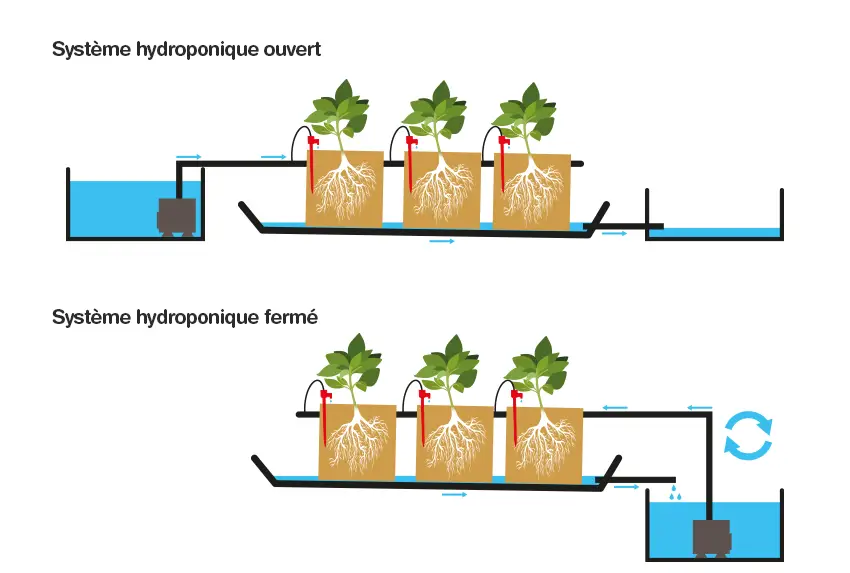
Hydroponics is an innovative method of growing plants without the use of soil. Instead, plants are grown in a nutrient-rich water solution that provides all the necessary elements for their growth and development. This technique has gained popularity in recent years due to its ability to maximize plant growth while conserving water and space.
One of the key advantages of hydroponics is the precise control it offers over the plant’s environment. By monitoring factors such as pH levels, temperature, and nutrient concentration, growers can create the ideal conditions for their plants to thrive. This level of control also allows for year-round cultivation, making hydroponics an attractive option for those living in regions with harsh climates or limited access to arable land. Furthermore, by eliminating the need for soil, hydroponics minimizes the risk of soil-borne diseases and pests, resulting in healthier and more productive plants.
• Hydroponics is an innovative method of growing plants without soil
• Plants are grown in a nutrient-rich water solution
• Maximizes plant growth while conserving water and space
• Precise control over the plant’s environment, including pH levels, temperature, and nutrient concentration
• Allows for year-round cultivation regardless of climate or limited access to arable land
• Eliminates the risk of soil-borne diseases and pests resulting in healthier plants.
The Basics of Hydroponic Systems
Hydroponic systems are a modern and innovative way of growing plants without soil. Instead, these systems use nutrient-rich water to deliver all the necessary elements for a plant’s growth. By utilizing this technology, gardeners can cultivate plants indoors, in limited spaces, and even in urban environments.
One of the key components of hydroponic systems is the growing medium. Unlike traditional soil-based gardening, where plants rely on soil for stability and nutrient absorption, hydroponics substitutes the growing medium with materials like perlite, vermiculite, coconut fiber, or rockwool. These mediums provide support for the plant’s roots while also allowing adequate airflow and water retention. With a well-balanced nutrient solution and the right growing medium, hydroponic plants can thrive and produce high yields in a fraction of the time compared to traditional gardening methods.
• Hydroponic systems use nutrient-rich water instead of soil to grow plants
• This technology allows for indoor and urban gardening
• Growing mediums like perlite, vermiculite, coconut fiber, or rockwool are used in hydroponics
• These mediums provide support for plant roots and allow for airflow and water retention
• With the right nutrients and growing medium, hydroponic plants can thrive and produce high yields quickly.
Different Types of Hydroponic Systems
Passive hydroponic systems are designed to operate without the use of pumps or electricity. One example of a passive system is the wick system, where a wick is used to draw the nutrient solution from a reservoir to the plants. This system is simple and low-maintenance, making it a great choice for beginners. Another example is the ebb and flow system, where the nutrient solution is flooded into a tray and then drained back into a reservoir. This system provides more oxygen to the roots and gives the plants a periodic dry period, which can be beneficial for their growth.
On the other hand, active hydroponic systems require the use of pumps to circulate the nutrient solution. One common type is the nutrient film technique (NFT) system, where a thin film of nutrient solution flows over the roots of the plants, providing them with a constant supply of nutrients. This system is efficient and allows for rapid growth. Another type is the deep water culture (DWC) system, where the plants are suspended in a nutrient solution with their roots submerged, allowing for maximum oxygenation. Active systems require more monitoring and maintenance, but they offer more control over nutrient delivery and plant growth.
• Passive hydroponic systems:
– Wick system: Uses a wick to draw nutrient solution to the plants.
– Ebb and flow system: Nutrient solution is flooded into a tray and then drained back into a reservoir.
• Active hydroponic systems:
– Nutrient film technique (NFT) system: Thin film of nutrient solution flows over the roots.
– Deep water culture (DWC) system: Plants are suspended in a nutrient solution with submerged roots.
• Passive systems are simple, low-maintenance, and great for beginners.
• Active systems require pumps for nutrient circulation but offer more control over growth.
• NFT provides constant nutrients and promotes rapid growth.
• DWC maximizes oxygenation for plant roots.
Key Features of Passive Hydroponic Systems
Passive hydroponic systems are a popular choice among gardening enthusiasts due to their simplicity and low maintenance requirements. One key feature of passive hydroponics is that they do not require any pumps or electricity to operate. Instead, they rely on the principle of capillary action, where the plants draw up water and nutrients from a reservoir through a wicking medium. This makes passive systems highly energy-efficient and cost-effective.
Another important feature of passive hydroponic systems is their versatility. They can be used with a variety of wicking materials such as coconut coir, perlite, or vermiculite, allowing for customization based on the specific needs of different plants. Moreover, passive systems can accommodate various types of growing containers, including buckets, trays, or even PVC pipes, making them adaptable to different spaces and gardening setups.
Overall, the key features of passive hydroponic systems include their simplicity, low maintenance requirements, and versatility. These systems are ideal for gardening enthusiasts who are looking for an easy and efficient way to grow plants without the need for complex equipment or constant monitoring. Passive hydroponics offers a sustainable and cost-effective solution for indoor and outdoor gardening, allowing individuals to experience the benefits of hydroponics without the associated challenges.
• Passive hydroponic systems do not require pumps or electricity to operate
• They rely on capillary action for water and nutrient uptake by plants
• This makes passive systems energy-efficient and cost-effective
• Passive systems can be used with various wicking materials such as coconut coir, perlite, or vermiculite
• This allows customization based on the specific needs of different plants
• They can accommodate different types of growing containers like buckets, trays, or PVC pipes
• This makes them adaptable to different spaces and gardening setups
• Passive hydroponic systems are simple to set up and require low maintenance
• Ideal for gardening enthusiasts who want an easy and efficient way to grow plants without complex equipment or constant monitoring
• Offers a sustainable and cost-effective solution for indoor and outdoor gardening.
Advantages of Passive Hydroponic Systems
Passive hydroponic systems offer several advantages that make them a popular choice among gardening enthusiasts. One key advantage is their simplicity and ease of use. Unlike active hydroponic systems that require pumps, timers, and other equipment, passive systems operate without any mechanical parts. This means that they are less complex and easier to set up and maintain.
Another advantage of passive hydroponic systems is their lower energy requirement. As these systems do not rely on pumps or electricity to circulate nutrients, they consume significantly less energy compared to active systems. This not only reduces the overall operational costs but also makes passive systems more environmentally friendly. In a time where sustainability is a growing concern, this feature of passive hydroponics sets it apart as an eco-conscious gardening option.
Moreover, passive hydroponic systems are known for their reliability and stability. Once properly set up, these systems provide a consistent and balanced supply of nutrients to the plants, ensuring optimal growth and yield. The absence of mechanical parts also means fewer chances of malfunction or failure, making passive hydroponics a dependable choice for gardeners looking for a low-maintenance solution.
Overall, passive hydroponic systems offer simplicity, energy efficiency, and reliable performance, making them an attractive option for gardening enthusiasts seeking an effective and sustainable way to grow plants hydroponically.
• Simplicity and ease of use
• Lower energy requirement
• Environmentally friendly
• Reliability and stability
Disadvantages of Passive Hydroponic Systems
Passive hydroponic systems, while offering several advantages, also come with a few disadvantages that gardeners and enthusiasts should be aware of. One of the main drawbacks of passive hydroponic systems is their limited ability to control nutrient levels. In these systems, nutrients are not delivered directly to the roots but are instead absorbed by the growing medium through capillary action. This can lead to uneven distribution of nutrients, potentially resulting in nutrient deficiencies or excesses for certain plants. These imbalances can adversely affect plant growth and development, leading to reduced yields and poorer crop quality.
Another disadvantage of passive hydroponic systems is their susceptibility to water-related issues. Unlike active hydroponic systems that use pumps and timers to regulate water flow, passive systems rely on the wicking action of the growing medium to provide moisture to the plants. This can sometimes lead to problems such as waterlogging or inadequate water supply, especially if the wicking material becomes clogged or saturated. Additionally, the lack of active water circulation can create stagnant conditions, which may encourage the growth of algae, fungi, or other pests that can harm the plants. Proper monitoring and maintenance are crucial to prevent these issues and ensure the optimal functioning of passive hydroponic systems.
• Limited ability to control nutrient levels
– Nutrients absorbed by growing medium through capillary action
– Uneven distribution of nutrients can lead to deficiencies or excesses in plants
– Adversely affects plant growth, yields, and crop quality
• Susceptibility to water-related issues
– Relies on wicking action of growing medium for moisture supply
– Potential problems such as waterlogging or inadequate water supply
– Lack of active water circulation may encourage the growth of pests like algae or fungi
• Proper monitoring and maintenance are crucial for optimal functioning
Key Features of Active Hydroponic Systems
Active hydroponic systems are designed to provide plants with a continuous supply of nutrient-rich water. These systems have a few key features that distinguish them from passive hydroponic systems. One of the main features of active systems is the use of pumps to circulate the nutrient solution. This ensures that the roots of the plants receive a constant supply of oxygen and nutrients, promoting healthy growth.
Another important feature of active hydroponic systems is the use of a reservoir to hold the nutrient solution. The reservoir is typically equipped with a float valve or a timer-controlled pump, which helps maintain the correct level of nutrient solution and prevents overwatering. This feature allows for precise control over the nutrient levels, pH, and temperature, ensuring optimal growing conditions for the plants.
Active systems also often use drip or spray irrigation to deliver the nutrient solution directly to the roots of the plants. This method allows for efficient nutrient uptake and minimizes waste, as the excess solution can be collected and recycled. Additionally, these systems can be easily automated, with sensors and timers controlling the irrigation cycles and nutrient dosing. This automation simplifies the maintenance process and allows for consistent and precise nutrient delivery.
In conclusion, the key features of active hydroponic systems include the use of pumps for nutrient circulation, a reservoir for nutrient solution storage, and drip or spray irrigation for precise nutrient delivery. These features enable optimal nutrient uptake, facilitate automation, and provide growers with greater control over the growing conditions. Active systems are ideal for those seeking a more hands-on approach to hydroponic gardening and for environments where precise control over nutrient delivery is necessary.
• Use of pumps for nutrient circulation
• Reservoir for nutrient solution storage
• Drip or spray irrigation for precise nutrient delivery
• Continuous supply of oxygen and nutrients to promote healthy growth
• Float valve or timer-controlled pump to prevent overwatering
• Precise control over nutrient levels, pH, and temperature
• Efficient nutrient uptake and minimal waste
• Automation with sensors and timers for consistent and precise nutrient delivery
• Greater control over growing conditions
• Ideal for hands-on hydroponic gardening
• Suitable for environments requiring precise nutrient delivery.
Advantages of Active Hydroponic Systems
Active hydroponic systems offer several advantages over passive systems, making them a popular choice among gardening enthusiasts. One key advantage is the level of control they provide. With active hydroponics, gardeners have the ability to fine-tune and regulate various environmental factors such as temperature, humidity, and nutrient levels. This precise control allows for optimal growing conditions, resulting in healthier and more productive plants.
Another advantage of active hydroponic systems is the ability to deliver nutrients directly to the plant’s root system. In traditional soil-based gardening, plants must extract nutrients from the surrounding soil, which can be inconsistent and inefficient. In active hydroponics, however, nutrient solutions are delivered directly to the roots, ensuring that plants receive the necessary elements in the right proportions. This targeted approach leads to faster growth, improved nutrient uptake, and ultimately, higher yields.
Active hydroponic systems also offer the benefit of automated watering and feeding. With the use of timers or sensors, gardeners can set up a schedule for watering and nutrient delivery, eliminating the need for manual monitoring and ensuring that plants receive consistent care. This automation not only saves time and effort but also helps to prevent common issues such as overwatering or nutrient deficiencies.
In conclusion, active hydroponic systems provide precise control over growing conditions, deliver nutrients directly to plant roots, and offer automated watering and feeding. These advantages make them an attractive option for gardening enthusiasts seeking to optimize plant growth and maximize yields. However, it’s important to consider the specific needs of different plant species and the associated costs and maintenance requirements before selecting an active hydroponic system.
• Active hydroponic systems provide precise control over environmental factors such as temperature, humidity, and nutrient levels.
• Nutrients are delivered directly to the plant’s root system in active hydroponics, ensuring consistent and efficient nutrient uptake.
• Automated watering and feeding in active hydroponic systems save time and effort for gardeners.
• These advantages lead to healthier plants, faster growth, improved nutrient uptake, and higher yields.
• It is important to consider the specific needs of different plant species and associated costs before selecting an active hydroponic system.
Disadvantages of Active Hydroponic Systems
Active hydroponic systems, while offering numerous advantages, also come with their fair share of disadvantages. One major drawback is the high energy consumption associated with these systems. Since active hydroponics relies on pumps, fans, and other electrical components to circulate and aerate the nutrient solution, the energy costs can be significant. This not only contributes to higher operational expenses but also makes active systems less environmentally friendly compared to passive systems.
Another disadvantage of active hydroponics is the increased risk of equipment failure. With the reliance on electrical components, there is always the possibility of malfunctions or breakdowns, which can disrupt the nutrient delivery and compromise the plants’ health. This can be particularly problematic if immediate action is not taken, as it could lead to nutrient deficiencies or sufficiencies, affecting the overall growth and productivity of the plants. Therefore, regular monitoring and maintenance are crucial to ensuring the smooth operation of active hydroponic systems.
• High energy consumption: Active hydroponic systems rely on pumps, fans, and other electrical components, leading to significant energy costs and higher operational expenses.
• Environmental impact: The high energy consumption of active hydroponics makes these systems less environmentally friendly compared to passive systems.
• Increased risk of equipment failure: With the reliance on electrical components, there is always a possibility of malfunctions or breakdowns, which can disrupt nutrient delivery and compromise plant health.
• Potential for nutrient deficiencies or sufficiencies: Equipment failures in active hydroponic systems can lead to imbalances in nutrient delivery, affecting the overall growth and productivity of plants.
• Need for regular monitoring and maintenance: To ensure the smooth operation of active hydroponic systems, regular monitoring and maintenance are crucial.
Comparison between Passive and Active Hydroponic Systems
Passive and active hydroponic systems are two common methods used for growing plants without soil. While both systems are effective in their own ways, there are distinct differences that gardening enthusiasts should consider before choosing between them.
Passive hydroponic systems operate without the use of pumps or electricity. Instead, these systems rely on a wicking medium, such as coconut coir or perlite, to transfer water and nutrients to the plants’ roots. This simplicity makes passive systems easy to set up and maintain, making them an excellent choice for beginners or those seeking a low-maintenance option. However, it’s important to note that the lack of active circulation in passive systems can lead to potential issues such as stagnant water or uneven nutrient distribution.
In contrast, active hydroponic systems utilize pumps and other equipment to circulate water and nutrients. This continuous circulation ensures that plants receive a steady supply of water and nutrients, leading to faster growth rates and higher yields. Active systems also offer more control over environmental factors such as temperature and nutrient concentrations, allowing gardeners to tailor conditions to specific plant requirements. However, this added complexity can be challenging for beginners and typically requires more investment in equipment and maintenance.
In conclusion, each hydroponic system has its advantages and disadvantages. Gardeners should consider their level of experience, available resources, desired level of involvement, and specific plant requirements when deciding between passive and active systems. By understanding these differences, individuals can make an informed choice that best suits their needs and goals for successful hydroponic gardening.
• Passive hydroponic systems operate without the use of pumps or electricity.
• These systems rely on a wicking medium, such as coconut coir or perlite, to transfer water and nutrients to the plants’ roots.
• Passive systems are easy to set up and maintain, making them an excellent choice for beginners or those seeking a low-maintenance option.
• However, potential issues such as stagnant water or uneven nutrient distribution can arise due to the lack of active circulation.
• Active hydroponic systems utilize pumps and other equipment to circulate water and nutrients.
• Continuous circulation ensures that plants receive a steady supply of water and nutrients, leading to faster growth rates and higher yields.
• Active systems offer more control over environmental factors such as temperature and nutrient concentrations.
• This allows gardeners to tailor conditions to specific plant requirements.
• Active hydroponic systems can be challenging for beginners due to their added complexity.
• They typically require more investment in equipment and maintenance compared to passive systems.
In conclusion:
– Gardeners should consider their level of experience when choosing between passive and active hydroponic systems.
– Available resources should also be taken into account since active systems require more investment in equipment.
– The desired level of involvement is another factor; passive systems are low-maintenance while active ones require regular monitoring.
– Specific plant requirements should also be considered since active systems allow better control over environmental factors.
By considering these aspects, individuals can make an informed choice that best suits their needs for successful hydroponic gardening.
Factors to Consider when Choosing a Hydroponic System
When choosing a hydroponic system, there is a range of factors to consider that will determine the success of your gardening endeavors. The first and most crucial factor is the type of plants you intend to grow. Different plants have varying nutrient requirements, growth rates, and space needs, so it is essential to select a system that can accommodate the specific needs of your chosen plants. Additionally, consider the size of your available space, as larger systems may be too cumbersome for smaller areas. It is also important to evaluate the scalability of the system, as you may want to expand your garden in the future. Lastly, keep in mind the level of complexity you are comfortable with. While some hydroponic systems require more technical knowledge and maintenance, others are simpler and more user-friendly for beginners. By carefully considering these factors, you can select a hydroponic system that suits your gardening goals and ensures optimal plant growth.
Another vital factor to consider when choosing a hydroponic system is your budget. The costs associated with different systems can vary widely, from affordable DIY setups to more high-tech, expensive options. It is crucial to weigh the upfront costs of purchasing or building the system against the potential long-term savings in terms of water, nutrient usage, and the overall yield of your crops. Additionally, think about the ongoing maintenance costs, including replacement parts, energy usage, and the need for specialized tools or equipment. Furthermore, consider the availability and accessibility of the necessary supplies and equipment for your chosen system, as this can affect both cost and convenience. By carefully assessing your budget, you can select a hydroponic system that not only meets your gardening needs but also fits comfortably within your financial means.
• Consider the type of plants you intend to grow and their specific nutrient requirements, growth rates, and space needs.
• Evaluate the size of your available space and choose a system that can fit comfortably within it.
• Assess the scalability of the system to determine if it can accommodate future expansion plans.
• Determine your comfort level with technical knowledge and maintenance required for different hydroponic systems.
• Consider your budget, including upfront costs, long-term savings in water and nutrient usage, and ongoing maintenance expenses.
• Think about the availability and accessibility of necessary supplies and equipment for your chosen system.
Costs Associated with Passive and Active Hydroponic Systems
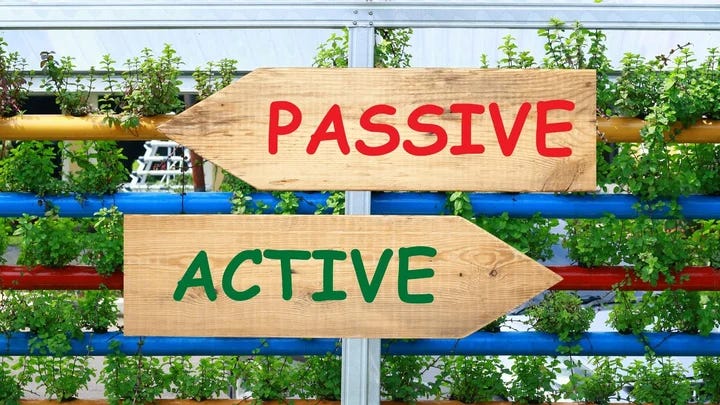
The costs associated with passive and active hydroponic systems can vary depending on various factors such as the size of the system, the type of plants being grown, and the specific equipment used. Generally, passive hydroponic systems tend to be more cost-effective compared to active systems.
Passive hydroponic systems require fewer components and are typically simpler in design, resulting in lower upfront costs. The basic setup usually includes a growing tray, a reservoir for nutrient solution, a wick or capillary mat to deliver nutrients to the plants, and a growing medium. These components are relatively inexpensive and can be easily sourced.
On the other hand, active hydroponic systems involve the use of pumps, timers, aerators, and other mechanical components to circulate and oxygenate the nutrient solution. These additional components can drive up the initial costs of setting up an active system. In addition, active systems may have higher ongoing energy costs due to the operation of pumps and aerators.
However, it’s important to note that the overall costs of both passive and active hydroponic systems can be influenced by factors such as electricity rates, water availability, and the specific requirements of the plants being grown. It’s advisable to assess your specific needs and budget when choosing between passive and active systems.
• Passive hydroponic systems tend to be more cost-effective compared to active systems.
• The basic setup for a passive system includes a growing tray, nutrient reservoir, wick or capillary mat, and growing medium.
• These components are relatively inexpensive and easy to source.
• Active hydroponic systems involve the use of pumps, timers, aerators, and other mechanical components.
• These additional components can drive up the initial costs of setting up an active system.
• Active systems may also have higher ongoing energy costs due to pump and aerator operation.
• Overall costs can be influenced by factors such as electricity rates, water availability, and plant requirements.
• It’s important to assess specific needs and budget when choosing between passive and active hydroponic systems.
Maintenance Requirements for Passive and Active Hydroponic Systems
Maintenance is an essential aspect of any hydroponic system, both passive and active. Keeping your system well-maintained will not only ensure the optimal growth of your plants but also prevent any potential issues that may arise.
In passive hydroponic systems, maintenance requirements are relatively low compared to active systems. The key maintenance tasks involve monitoring and adjusting the water level and nutrient solution. It is essential to regularly check the water levels to ensure that the plants are receiving sufficient hydration. Additionally, monitoring the nutrient solution’s pH and electrical conductivity (EC) levels is crucial, as imbalances can hinder plant growth. Regularly inspecting the system for any clogs, leaks, or nutrient deficiencies is also necessary to address any issues promptly. Overall, passive hydroponic systems require less frequent attention and maintenance, making them a preferred choice for those seeking a low-maintenance option.
On the other hand, active hydroponic systems often require more regular and involved maintenance. This is mainly due to the additional components and processes involved. In an active system, maintenance tasks include monitoring and adjusting the water and nutrient solution, as well as maintaining the pumps, timers, and other equipment. Monitoring and maintaining the pH and EC levels become even more critical in active systems, as they directly affect the performance of the nutrient delivery system. Additionally, regular cleaning and sanitization of the system components are essential to prevent the growth of algae, bacteria, and other potential contaminants. Although active systems may require more maintenance, they offer precise control over the growing conditions and thus provide an ideal environment for higher-yielding plants.
• Regularly monitor and adjust water levels in passive hydroponic systems
• Monitor pH and EC levels of the nutrient solution in passive systems
• Inspect system for clogs, leaks, or nutrient deficiencies in passive systems
• Passive hydroponic systems require less frequent attention and maintenance
• Active hydroponic systems require more regular and involved maintenance
• Monitor and adjust water and nutrient solution in active hydroponic systems
• Maintain pumps, timers, and other equipment in active systems
• Regularly clean and sanitize system components to prevent contaminants
• Precise control over growing conditions in active systems leads to higher-yielding plants
Suitability of Passive Hydroponic Systems for Different Plants
Passive hydroponic systems are known for their simplicity and ease of use, making them suitable for a wide range of plants. In particular, leafy greens and herbs thrive in passive systems, as they generally have shallow root systems and do not require excessive amounts of water or nutrients. Plants like lettuce, spinach, kale, and basil have been successfully grown in passive systems, benefiting from the consistent moisture levels and nutrient availability that these systems provide. Additionally, passive systems are also suitable for growing small to medium-sized fruiting plants such as tomatoes, peppers, and strawberries, as long as the appropriate support structures are in place.
Furthermore, passive systems are ideal for plants that prefer a more stable environment, as they provide a more consistent water and nutrient supply compared to active systems. This makes them particularly well-suited for sensitive plant species that may struggle with fluctuations in water availability or nutrient levels. By offering a controlled and regulated growing environment, passive hydroponic systems create the perfect conditions for plants that have specific temperature, humidity, and light requirements. So, whether you are a beginner gardener or an experienced enthusiast, passive hydroponics can be an effective and reliable method for cultivating a variety of plants with great success.
• Leafy greens and herbs, such as lettuce, spinach, kale, and basil
• Small to medium-sized fruiting plants like tomatoes, peppers, and strawberries (with appropriate support structures)
• Plants that prefer a stable environment
• Sensitive plant species that struggle with fluctuations in water availability or nutrient levels
• Plants with specific temperature, humidity, and light requirements
Suitability of Active Hydroponic Systems for Different Plants
Active hydroponic systems are versatile and can be used to cultivate a wide range of plants. Some of the most popular plants for active hydroponic systems include leafy greens, such as lettuce, spinach, and kale. These plants have shallow root systems and thrive in nutrient-rich environments that active systems offer. Herbs like basil, mint, and cilantro are also well-suited for active hydroponic systems, as they require consistent moisture and nutrient levels.
Fruiting plants, such as tomatoes, cucumbers, and peppers, can also be successfully grown in active hydroponic systems. These plants require a higher nutrient concentration and benefit from the constant delivery of nutrients that active systems provide. Additionally, flowering plants like roses or orchids can thrive in active hydroponic systems with proper nutrient management and environmental control. The ability to customize the nutrient solution and adjust environmental factors, such as temperature and humidity, in active systems allows for optimal growth conditions for a wide variety of plants.
• Leafy greens: lettuce, spinach, kale
• Herbs: basil, mint, cilantro
• Fruiting plants: tomatoes, cucumbers, peppers
• Flowering plants: roses, orchids
Real-life Examples of Passive Hydroponic Systems
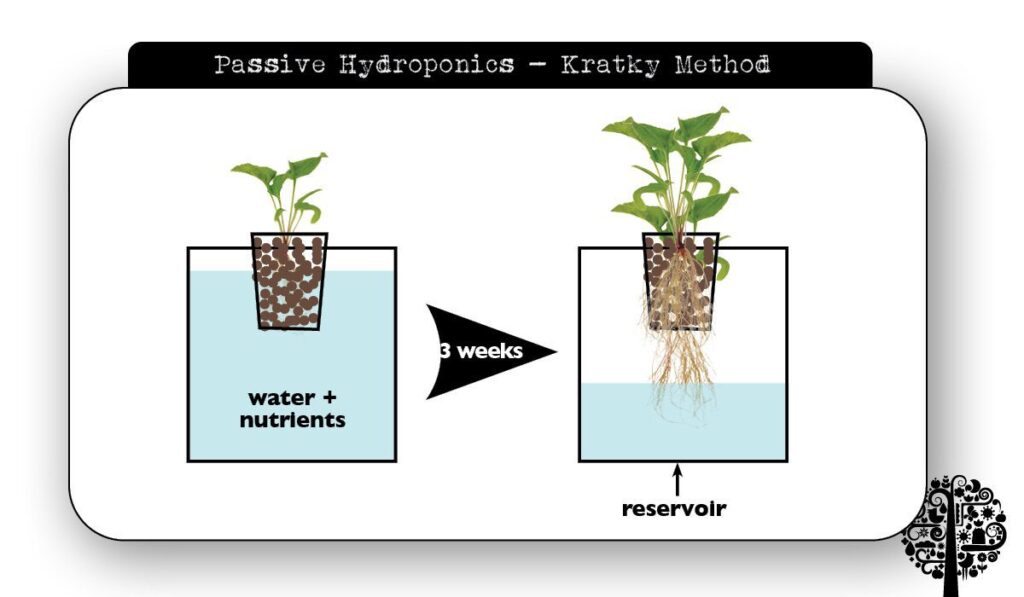
Passive hydroponic systems are becoming increasingly popular among gardening enthusiasts due to their simplicity and effectiveness. These systems work on the principle of capillary action, where the plants receive nutrients through a wick or a porous material without the need for pumps or electricity. Let’s explore a few real-life examples of passive hydroponic systems that have demonstrated outstanding results.
One fascinating example is the wick system, which is commonly used for growing herbs and small vegetables. In this system, a wick made of cotton or similar material is submerged in a nutrient solution reservoir and placed in close proximity to the plant roots. The wick absorbs the nutrient solution and delivers it directly to the roots, promoting healthy growth. This method is easy to set up and is ideal for beginners or those with limited space.
Another noteworthy example of a passive hydroponic system is the Dutch bucket system. This system involves the use of buckets filled with a substrate, such as perlite or coconut coir, where the plants are grown. The buckets are connected to a nutrient solution reservoir through a series of pipes. Through capillary action, the plants draw up the required nutrients from the reservoir and thrive in an optimal growing environment. The Dutch bucket system is particularly suited for larger plants, including tomatoes and cucumbers, and has been proven to yield impressive harvests.
These real-life examples serve as a testament to the effectiveness and versatility of passive hydroponic systems. Whether you’re a novice gardener or an experienced horticulturist, incorporating such systems into your indoor or outdoor setup can provide you with a rewarding and fruitful gardening experience. Stay tuned as we delve further into the world of hydroponics and explore the intriguing realm of active hydroponic systems.
– Wick system:
– Uses a wick made of cotton or similar material
– Submerged in a nutrient solution reservoir
– Delivers nutrients directly to plant roots through capillary action
– Ideal for growing herbs and small vegetables
– Dutch bucket system:
– Involves the use of buckets filled with substrate (perlite or coconut coir)
– Plants draw up required nutrients from a reservoir through capillary action
– Suited for larger plants like tomatoes and cucumbers
– Passive hydroponic systems are effective, versatile, and easy to set up.
– Suitable for both novice gardeners and experienced horticulturists.
– Can be incorporated into indoor or outdoor gardening setups.
– Provides rewarding and fruitful gardening experiences.
Here’s a comparison table highlighting the differences between Passive and Active Hydroponic Systems:
| Aspect | Passive Hydroponic Systems | Active Hydroponic Systems |
|---|---|---|
| Definition | Relies on the capillary action and wicking to deliver nutrients to plants without the use of pumps. | Utilizes a pump to actively circulate nutrient solutions, providing more control over nutrient delivery. |
| Nutrient Circulation | Nutrient movement is driven by natural forces like capillary action or gravity. | Nutrient solution is actively circulated using pumps, ensuring more consistent and controlled delivery. |
| Complexity | Generally simpler and less complex in terms of setup and maintenance. | Often more complex due to the use of pumps, timers, and monitoring systems. Requires more active management. |
| Energy Consumption | Typically lower energy consumption since there are no pumps or electrical components involved. | Requires energy for pumps, air stones, and other active components, resulting in higher energy consumption. |
| Examples | 1. Wick System | 1. Nutrient Film Technique (NFT) |
| 2. Deep Water Culture (DWC) | 2. Drip Systems | |
| 3. Kratky Method | 3. Aeroponics | |
| Water Usage | Can be more water-efficient as the system uses water only as needed by the plants. | May require more water due to active circulation, but can be optimized for water efficiency. |
| Risk of System Failure | Lower risk since there are fewer components that can malfunction. | Higher risk due to the involvement of pumps and other mechanical parts that can fail. Regular monitoring is essential. |
| Cost | Generally lower initial and operational costs. | May have higher initial and operational costs due to the need for pumps and additional equipment. |
| Suitability for Beginners | More beginner-friendly as they are simpler to set up and require less monitoring. | May be more challenging for beginners due to the complexity of the system and the need for precise management. |
This table provides a comparison between Passive and Active Hydroponic Systems, considering factors such as nutrient circulation, complexity, energy consumption, examples, water usage, risk of system failure, cost, and suitability for beginners. The choice between the two depends on factors like the grower’s experience, resources, and specific crop requirements.
Real-life Examples of Active Hydroponic Systems
In real-life examples of active hydroponic systems, one notable success story is the vertical farming company, Plenty. Based in San Francisco, Plenty utilizes state-of-the-art technology and advanced hydroponic techniques to grow a variety of leafy greens, herbs, and microgreens. Their vertical farming system maximizes space efficiency by growing crops in stacked trays, allowing for a higher yield in a smaller footprint compared to traditional farming methods. With the use of nutrient-rich water and precise LED lighting, Plenty is able to tailor the growing conditions to the specific needs of each plant, resulting in faster growth and consistent, high-quality produce year-round.
Another fascinating example of an active hydroponic system can be found at Metropolis Farms in Philadelphia. This urban farm is housed within a repurposed warehouse, where hydroponic systems are used to cultivate a wide range of crops including lettuce, spinach, and basil. By closely monitoring and controlling the environmental factors such as temperature, humidity, and nutrient levels, Metropolis Farms is able to optimize plant growth and achieve impressive yields. The farm also incorporates innovative technology, such as automated nutrient delivery systems and intelligent lighting systems, to ensure optimal conditions for plant health and productivity. Through their active hydroponic system, Metropolis Farms demonstrates the potential of urban agriculture to provide fresh and sustainable produce to local communities.
• Plenty, a vertical farming company in San Francisco, utilizes advanced hydroponic techniques to grow leafy greens, herbs, and microgreens.
• Their vertical farming system maximizes space efficiency by growing crops in stacked trays.
• Nutrient-rich water and precise LED lighting are used to tailor the growing conditions for each plant.
• This results in faster growth and consistent, high-quality produce year-round.
• Metropolis Farms in Philadelphia is an urban farm housed within a repurposed warehouse.
• Hydroponic systems are used to cultivate crops like lettuce, spinach, and basil.
• Environmental factors such as temperature, humidity, and nutrient levels are closely monitored and controlled for optimal plant growth.
• The farm incorporates automated nutrient delivery systems and intelligent lighting systems for maximum productivity.
Both of these real-life examples demonstrate the potential of active hydroponic systems:
– They maximize space efficiency compared to traditional farming methods
– Tailoring growing conditions leads to faster growth and higher-quality produce
– Close monitoring of environmental factors optimizes plant growth
– Innovative technology enhances productivity
– Active hydroponic systems have the potential to provide fresh and sustainable produce locally.
Can I use hydroponics to grow large plants like trees?
While hydroponics is primarily used for growing smaller plants and herbs, there are advanced systems that can support the growth of larger plants, including trees. However, the size and weight of the plants may require additional structural support and careful consideration of nutrient and water delivery.
Are there any limitations to what types of plants can be grown using hydroponics?
Hydroponics can be used to grow a wide variety of plants, including herbs, vegetables, and even some flowers. However, certain plants with extensive root systems or specific soil requirements may be more challenging to grow in a hydroponic system. It is important to research and understand the specific needs of the plants you wish to grow.
How often do I need to monitor and adjust pH levels in a hydroponic system?
pH levels in a hydroponic system should be monitored regularly, ideally on a daily basis. The pH levels can fluctuate due to various factors, such as nutrient uptake or changes in water quality. Adjustments to pH levels may be necessary to ensure optimal nutrient absorption by the plants.
Can I use regular tap water for my hydroponic system?
It is generally recommended to use filtered or distilled water for hydroponic systems to avoid potential contaminants or mineral build-up. Regular tap water may contain chlorine, chloramines, or other chemicals that can negatively affect plant growth. However, if tap water is your only option, it can be used with proper filtration or by allowing it to sit for 24 hours to allow chlorine to dissipate.
How long can hydroponically grown plants survive without water or power?
The survival time of hydroponically grown plants without water or power can vary depending on the specific plant species and environmental conditions. Generally, most plants can survive for a few days to a week without water, but prolonged periods without water or power can lead to irreversible damage or plant death. It is important to have backup power sources and contingency plans in place to ensure the continuous operation of the hydroponic system.
Can I use organic fertilizers in a hydroponic system?
While hydroponic systems are often associated with the use of synthetic fertilizers, it is possible to use organic fertilizers. However, organic fertilizers may require additional steps to ensure they do not clog or contaminate the system. It is important to carefully research and select organic fertilizers that are specifically designed for hydroponic use.
Is it possible to grow hydroponic plants outdoors?
Yes, hydroponic systems can be set up outdoors, provided that the necessary environmental conditions are met. Outdoor hydroponics requires careful consideration of factors such as temperature, sunlight exposure, and protection from pests and extreme weather conditions. It may be necessary to use shade structures, netting, or other methods to provide the optimal growing environment for outdoor hydroponic plants.
Can I switch from a passive hydroponic system to an active one, or vice versa?
Yes, it is possible to switch between passive and active hydroponic systems. However, it may require certain modifications to the existing setup, such as the addition or removal of pumps, timers, or other components. It is important to carefully plan and research the specific requirements and adjustments needed to transition between the two types of systems.


